SCOPE OF POULTRY WASTE MANAGEMENT AND UTILIZATION
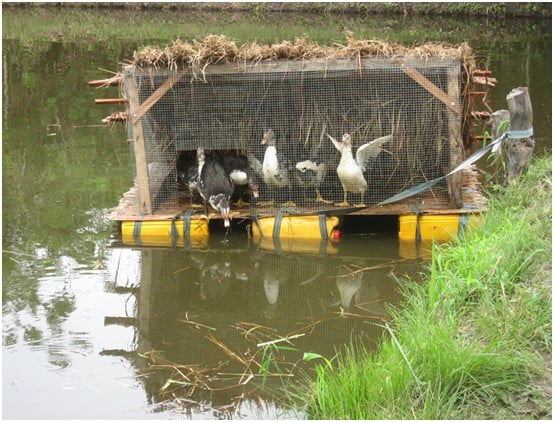
Dr. Richa Tiwari, BVSc & AH, MVSc (Veterinary Public Health and Epidemiology)
Former Research Scholar, School of Public Health and Zoonoses, Guru Angad Dev Veterinary and Animal Sciences University, Ludhiana, Punjab, India.
INTRODUCTION
Poultry is one of the fastest growing segments of the agricultural sector in India. Crop production alone may not solve the food difficulty of the fast growing population of our country, thus poultry production has been the appropriate answer for fulfilment of requirements of balanced diet. Advancement in knowledge and technology intensifies the growth of poultry production in developing countries where there are economic constraints. In India Poultry meat, contributes approx 47 – 50 percent of total meat production. With the expanding wings of poultry industry, it’s also increasing the challenges to properly manage the waste produced from it. The poultry industry produces large amounts of hatchery waste which includes solid waste and wastewater. The solid hatchery waste includes empty shells, bedding material, excreta, feed, feathers, infertile eggs, dead embryos, late hatchings and dead chickens and a viscous liquid from eggs and decaying tissue. Water used to wash incubators, hatchers and chick handling areas produces the wastewater. Apart from this wastewater also comes from faeces, urine, saw dust, remnants of drugs pesticides and disinfection of chicken houses and abattoirs.
Hatchery waste is very rich in protein containing around 33 % crude protein (CP). Poultry waste also lead to pollution of environment, through its offensive odours, promotion of fly and rodent breeding, high protein waste and high nitrogen losses. These further result in enrichment of ground water through seepage, lakes or streams, pathogen distribution, production of phytotoxic substances, air pollution and greenhouse gas emissions. Therefore proper disposal and management of poultry waste is very essential.
HATCHERY WASTE MANAGEMENT AND UTILIZATION
I. SOIL AMENDMENT
Application of poultry manure improve water holding capacity of soil thereby improving irrigation potentiality, physical properties of degraded soil and decreasing the dryness of soils . Thus spreading poultry manure thinly on the soil instead of dumping in a heap is one of the way for soil improvement.
II. LIVESTOCK FEEDING
Poultry litter has been used in diets for poultry, lambs, ewes, swine, lactating cows etc. The maximum inclusion rate of poultry waste in ruminant feeds is 20% [National Research Council (NRC) (1984)]. Adding poultry litter into buffalo or cattle rations at a level of 20% or higher (as fed basis) fulfils crude protein, calcium and phosphorus requirement. Addition of poultry litter at a level of 30% into corn silage also known to have beneficiary effect. Dried poultry waste contains around 28% protein and is an excellent source of calcium, phosphorus, potassium, iron and zinc. It is suggested that ensiling poultry waste, i.e. slaughterhouse wastes with molasses and lactobacilli improves NPN and reduces pathogens. Advances in the treatment and processing of feathers and offal leads to production of value-added feed ingredients and are making this practice more attractive in some regions.
III. BIO ENERGY PRODUCTION
Poultry manure and litter is rich in organic matter which can be transform into bioenergy. In this process, manure is digested anaerobically that produces a gas mixture with varying concentrations of combustible methane. Biogas is a source of energy; it can be used as a fuel for engines, generation of electricity and other energy consuming purposes.
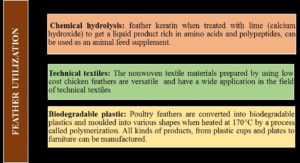
Feathers can be converted to feather meal for the usage as animal feed, organic fertilizers and feed supplements, as it is made up of >90% protein. Further feather utilization includes:
POULTRY WASTE DISPOSAL METHODS
The disposal of poultry carcasses has environmental, biological, and financial concern therefore they are not disposed of by dumping on any public road or right-of-way left where they may be consumed by animals.
There are several ways of disposing of poultry waste including; burial, rendering, incineration, compositing, feed for livestock, fertilizer or source of energy.
CONCLUSION
Poultry waste management is difficult and challenging, due to may of its linked problems, like nitrate and heavy metal contamination in crops, soil, water, offensive odour; disposal of dead birds and food safety. Feathers, blood, and other waste material are being processed and utilized as high-protein animal feed sources or as fertilizer due to its high nitrogen content. Poultry industry contributes an in economy of nation as well as improving the standard of living of people. The proper utilization and disposal of poultry waste will help in avoiding the unnecessary discomfort to living beings and environment. The decomposition of the waste must be done with proper handing and care to avoid any risk of disease outbreak and to prevent environment pollution.

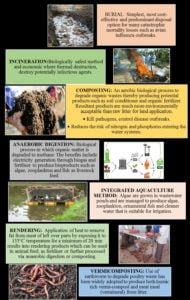

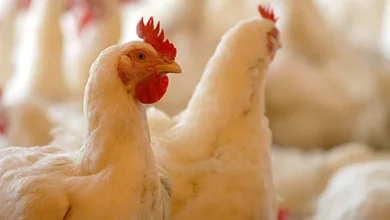
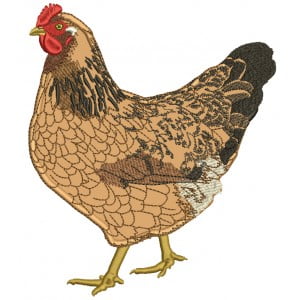
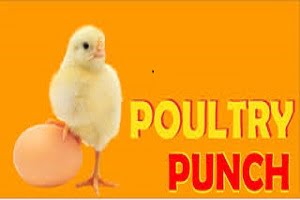

Again a great article …worth reading
I would be happy to thank you for the article which has been recently shared by you. It contains a lot of useful information for us!